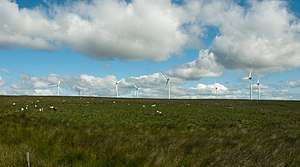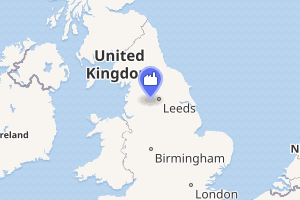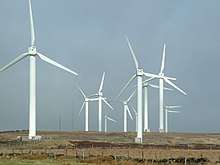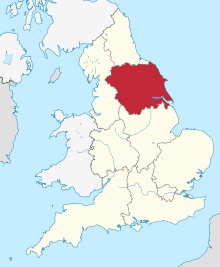Ovenden Moor Wind Farm
Ovenden Moor Wind Farm is a wind powered electricity generating site in England. Ovenden Moor is located north of Halifax and west of Bradford in West Yorkshire. The site was opened in 1993 with 23 turbines, but these were later removed in favour of larger turbines but with 14 fewer towers. This updated the output of the site from 9.2 MWh to 22.5 MWh with an expected generation lifetime of 25 years. As the turbines can be seen from some distance and the fact that they overlook the Brontë Country to the north, they have the subject of continued criticism and objections.
| Ovenden Moor Wind Farm | |
|---|---|
 The uprated windfarm at Ovenden Moor | |

| |
| Country | England |
| Location | Halifax |
| Coordinates | 53°46′32″N 1°56′13″W |
| Status | Operational |
| Construction began | 1992 2016[note 1] |
| Commission date | 1993 2017 |
| Construction cost | £12 million |
| Owner(s) | Yorkshire Wind Power Limited |
| Wind farm | |
| Type | Onshore |
| Hub height | 370 feet (110 m) (second generation) |
| Site elevation | 1,440 feet (440 m) |
| Power generation | |
| Make and model | Gamesa G80-2MW |
| Units planned | Ten |
| Units cancelled | One |
| Annual net output | 49 GWh |
| External links | |
| Commons | Related media on Commons |
Geology
This moorland area of the South Pennines is mostly overlaid with peat and underlaid with sandstone that is 310 million years old.[1] The area in and around Ovenden Moor was quarried for the Rough Rock Flagstone that was used for buildings in the Halifax area.[2] There are also bands of mudstone and coal, with coal being worked historically in the area (east of Ovenden Moor)[3] even though the seams were very narrow by commercial colliery standards.[4]
History
The site was first proposed as a wind farm in the early 1990s and development took place soon after government approval was granted in 1992.[5] At a cost of £10.6 million, 23 turbines were erected at 1,440 feet (440 m) above sea level in a staggered V-shape to take advantage of the prevailing south-westerly wind.[6] The site first started generating power in June 1993.[5] The first generation wind turbines were designed and built by Vestas with a height of 166 feet (51 m) and would each generate 400 kWh[7] with the whole site generating 9.2 MWh in total.[8] The turbines on the site would start generating power at 11 miles per hour (18 km/h) and would reach their optimum power generation at 27 miles per hour (43 km/h).[9]
The power output from the site was fed via a sub-surface 11 kilovolt cable eastwards into the National Grid near to the village of Denholme.[10] The first generation site provided enough power for 5,600 homes[11] and stopped over 10,000 tonnes (11,000 tons) of carbon dioxide and over 90 tonnes (99 tons) of sulphur dioxide being released into the atmosphere.[12]
The development of the wind farm included many groundworks to locate the foundations in the peat that overlies the bedrock.[note 2][13] During the building phase, a crack in the bedrock, as a result of the earthworks, diverted a watercourse and the cabling works caused the peat to dry out. This has been cited by opponents of wind farm schemes across the United Kingdom when challenging the application process at the approvals stage.[14] Access from the local roads onto the moorland was developed using a special floating road of interwoven plastic grids. This was one of the first uses of this style of access to prevent degradation of the peat underlying the track of the road.[15] The wind farm was temporarily switched off in late April and early May 2010 due to an extensive moor fire that had to be tackled by the West Yorkshire Fire Service.[16]
Funding for the wind farm was supplied partly from the European Commission's Thermie Programme which was designed to help start renewable energy projects.[17] The Commission funded €2 million of the final €9.1 million towards the project. The builders of the wind farm were also required to report back to the EU to outlay the inherent planning, cost, infrastructure and operating problems of a windfarm on high moorland.[18]

The old turbines and towers were decommissioned by March 2015[19] and were replaced in 2016 by a £12 million scheme of 370 ft (110 m) tall newer generation units which are capable of generating 2.5 MWh each.[20] The total power output of the new wind farm is 22.5 MWh which meant that only four turbines need to be erected to supplant the power of the turbines they were replacing.[21] Spanish company Gamesa had won the contract and supplied nine of its G80 (2MW) turbines.[22] Planning was initially submitted for ten turbines in 2008, but was reformed and re-submitted in 2012 with one less turbine, downrating the power output from 25 MW to 22.5 MW.[19] The site is estimated to be generating electricity 95% of the time[10] and is believed to be able to generate 49 GWh per year (enough to supply over 11,000 homes) and would save over 21,000 tonnes (23,000 tons) of carbon dioxide being released into the environment over a year.[23] Ovenden Moor Repower started generating in early 2017, despite weather related delays in the construction of the site[24] and is expected to be generating electricity for 25 years.[25]
The older turbines suffered from a lower generation outputs due to wind strength, whereas the newer turbines have a higher rated resistance to damage from strong winds. The older turbines would automatically shut off when the wind was blowing above 56 miles per hour (90 km/h), although this was not enough to prevent damage as on at least one occasion, the sails of some of the turbines were ripped off in strong winds.[26] The newer turbines have been designed to withstand windspeeds of up to 150 miles per hour (240 km/h), a far higher threshold than the previous ones.[9]
The generating company is Yorkshire Wind Power Limited who operate two other wind farms at Royd Moor near to Penistone in South Yorkshire and Out Newton near to Easington in the East Riding of Yorkshire.[27] The first generation venture was a 50/50 joint enterprise between Yorkshire Water and Yorkshire Electricity.[12] Yorkshire Water sold their stake in the business in May 2002 to Energy Powers Resources.[28] Yorkshire Wind Power is now a joint 50/50 enterprise between E.ON Climate and Renewables and Energy Power Resources Ltd,[29] although the land is still owned by Yorkshire Water.[30] Operation of the wind farm is controlled remotely from E.ON's offices in Coventry in the West Midlands.[10]
The wind farm has been praised but has mostly been criticised by local people and also the local MP.[31][32] Whilst campaigners against the wind farm recognise that the it produces Low-carbon energy,[note 3][33][34] it was noted that the wind farm had only been operating for 31% of the time in 2005 and only 25% of the time in 2009.[35][36] The proximity to Haworth had raised objections by The Bronte Society and the local population that the turbines were despoiling the area and would have a negative effect on tourism to the region.[37] This was highlighted by local people when the plans for the new height of the wind turbines was being unveiled, with comments stating that their visibility will be further than ever before and attracting the view that it will despoil a huge swathe of Yorkshire,[38] (on a clear day, the turbines will be able to be seen from 35 miles (56 km) away).[20]
The location of the site is 4 miles (6 km) north of Halifax, 7 miles (12 km) west of Bradford, 3 miles (5 km) south of Haworth[39][40] and the area it overlooks to the north is designated as Brontë Country.[41] The site is closest to the village of Ogden and Ogden Reservoir (2 miles (2.5 km) to the south east), but the high ground it occupies is known as Ovenden Moor.[42] The site straddles the watershed between the waters that feed Warley Reservoir to the west, the Worth Valley to the north, the Calder Valley to the south, and Airedale and the Upper Bradford district to the east.[43]
Notes
- The first windfarm was constructed in 1992/1993 and decommissioned in 2015
- The peat overlies a bedrock of coal measures and millstone grit.
- Wind turbines can be carbon neutral after six months, but this timeframe is often expanded due to the need to build roads across peat moorland which dries out the peat and releases carbon dioxide into the atmosphere
References
- Tymon, Allison (2013). "Rocks and Landscapes of Ogden Clough, Halifax" (PDF). wyorksgeologytrust.org. p. 2. Retrieved 13 October 2017.
- "West and South Yorkshire's building stone atlas" (PDF). bgs.ac.uk. English Heritage. March 2012. pp. 13–14. Retrieved 13 October 2017.
- "Calderdale District Surface Coal Resource" (PDF). gov.uk. The Coal Authority. 6 April 2017. Retrieved 14 October 2017.
- "A walk around Ogden Water Calderdale, to look at rocks and landscapes" (PDF). wyorksgeologytrust.org. p. 2. Retrieved 14 October 2017.
- OMPR 2012, p. 5.
- "Yorkshire's great wind farm, Ogden Water, West Yorkshire". The Guardian. 9 June 2009. Retrieved 7 October 2017.
- Clark, Emma (December 2008). "Ovenden Moor Proposed Repower" (PDF). calderdale.gov.uk. Faber Maunsell. Retrieved 10 October 2017.
- Weston, David. "Gamesa wins UK repowering deal". windpowermonthly.com. Retrieved 10 October 2017.
- OMPR 2012, p. 14.
- Mead, Helen (23 June 2006). "Propelling the wind of change". Bradford Telegraph and Argus. Retrieved 8 October 2017.
- Wainwright, Martin (9 June 2009). "There's wind in them there hills: Martin Wainwright takes a tour of Ovenden Moor wind farm". The Guardian. Retrieved 7 October 2017.
- "Windfarm Facts". www.ogdenwater.org.uk. Retrieved 7 October 2017.
- "South Pennines Wind Energy Landscape Study" (PDF). calderdale.gov.uk. Julie Martin Associates. October 2014. p. 79. Retrieved 13 October 2017.
- "House of Commons - Welsh Affairs - Written Evidence". publications.parliament.uk. Retrieved 10 October 2017.
- "Wind Farm Access Road White Paper | Carbon Footprint | Wind Power" (PDF). scribd.com. Tensar. p. 2. Retrieved 10 October 2017.
- "Wildfires - West Yorkshire Fire & Rescue Service". westyorksfire.gov.uk. Retrieved 7 October 2017.
- "Ovenden Moor Wind Farm Renewable energy scheme / Wind". www.renewables-map.co.uk. Retrieved 7 October 2017.
- "Ovenden Moor Windfarm". cordis.europa.eu. Retrieved 7 October 2017.
- "Ovenden Moor Repower | Onshore - E.ON". www.eonenergy.com. Retrieved 7 October 2017.
- "Giant turbines to stride onto Ovenden Moor". Halifax Courier. 31 December 2015. Retrieved 7 October 2017.
- OMPR 2012, p. 1.
- "Wind - Gamesa to install nine turbines in UK wind farm repowering project - Renewable Energy Magazine, at the heart of clean energy journalism". renewablenergymagazine.com. Retrieved 7 October 2017.
- OMPR 2012, p. 69.
- Rahman, Miran (29 December 2016). "Work almost complete on installing nine new, modern wind turbines above Oxenhope". Bradford Telegraph and Argus. Retrieved 8 October 2017.
- OMPR ESA 2012, p. 79.
- "Windturbine blades 17 metres long ripped off in high winds". www.halifaxcourier.co.uk. 8 May 2013. Retrieved 9 October 2017.
- "Wind farm site put to test". The Yorkshire Post. 26 June 2006. Retrieved 7 October 2017.
- "Major deal by Kelda". Bradford Telegraph and Argus. 15 May 2002. Retrieved 8 October 2017.
- Rahman, Miran (8 September 2017). "Replacement wind turbines to be installed at Ovenden Moor". Keighley News. Retrieved 7 October 2017.
- OMPR 2012, p. 3.
- "Finances riddle". Bradford Telegraph and Argus. Wind of Change. 11 October 2008. Retrieved 10 October 2017.
- "Wind turbine scheme for moor is defended by boss". Bradford Telegraph and Argus. 25 June 2010. Retrieved 10 October 2017.
- Gilligan, Andrew (23 February 2013). "Wind farms will create more carbon dioxide, say scientists". The Telegraph. Retrieved 15 October 2017.
- "Life cycle costs and carbon emissions of wind power" (PDF). climatexchange.org.uk. 2015. p. 19. Retrieved 15 October 2017.
- Benfield, Chris (2 May 2005). "Fears for beauty spots as windfarms fail to deliver". The Yorkshire Post. Retrieved 9 October 2017.
- "Tony Lodge: Gone with the wind farm". The Yorkshire Post. 16 May 2011. Retrieved 9 October 2017.
- "Planners agree to bigger turbines". BBC News. 13 November 2012. Retrieved 7 October 2017.
- "The land of the giants! Wind turbines will be 120ft taller than Wainhouse Tower". www.halifaxcourier.co.uk. 24 July 2008. Retrieved 9 October 2017.
- "South Pennines" (Map). OL21. 1;25,000. Explorer. Ordnance Survey. 2015. ISBN 9780319242605.
- "Bradford & Huddersfield" (Map). 288. 1;25,000. Explorer. Ordnance Survey. 2015. ISBN 9780319244852.
- Young, Chris (8 November 2012). "Bronte Society fights Ovenden Moor wind farm plans". Bradford Telegraph and Argus. Retrieved 7 October 2017.
- OMPR ESA 2012, p. 73.
- Milne, Sarah (August 2012). "Oven Moor Wind Farm Proposed Repower Vol 1" (PDF). eonenergy.com. AECOM. p. 2. Retrieved 9 October 2017.
Sources
- Ovenden Moor Windfarm Proposed Repower (PDF) (Report). Harrogate: Signet Planning. August 2012.
- Ovenden Moor Windfarm Proposed Repower Volume 3; Environmental Statement Appendices (PDF) (Report). Cardiff: AECOM Environmental. August 2012.
External links
| Wikimedia Commons has media related to Ovenden Moor Wind Farm. |
